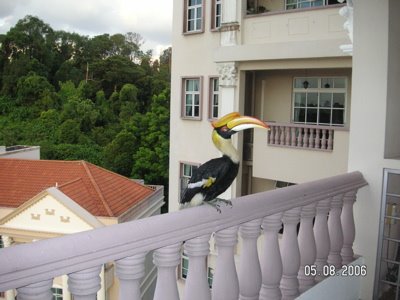On the evening of 5th August 2006, Matt Quin was pleasantly surprised when a large bird landed on the balcony of his apartment at Bukit Tinggi. He went into the web and found out that it was a Great Hornbill (Buceros bicronis). The bird had a metal ring around its right foot and he presumed rightly that it was an escapee from somewhere.
The hornbill was very comfortable with his presence and stayed for about 15 minutes before it flew off to the balcony of the apartment above his. Matt’s final words: “A truly impressive bird!”
Yes, the Great Hornbill is truly impressive. This appears to be the only one left, probably an escapee from Jurong Bird Park many, many years ago. It is still flying around the Bukit Timah area, surprising Singaporeans who are generally not familiar with these birds with its presence.
In March this year the bird visited Stephen Lau’s apartment, also in the Bukit Timah area. Apparently it roosts at night within the grounds of Brian Ng’s condomonium. An earlier posting gives an account of it pairing with the Rhinoceros Hornbill (B. rhinoceros), another impressive bird, and checking on a cavity in an old tree for a potential nest.
Input and images courtesy of Matt Quin.











5 Responses
Have you had any confirmation from Jurong Bird Park that they may have lost a hornbill? Could it be from a private collector? This is a great blog, I will be back.
There are people who actually saw JBP (or something like that) on the metal tag when the Great Hornbill was perched outside an apartment window in the Eng Neo area sometime back. Yes, we did ask JBP whether they lost a hornbill. But they said no. Maybe this bird escaped a very, very long time ago? Maybe it is free ranging?
I recall having one such hornbill perch on the ridge of my apartment’s balcony on some mornings, no less than 11 years ago. For all we know, it might be the same one since I was living around Bukit Timah. I’d be having breakfast before I went to school and sometimes I would toss it some fruits from my breakfast. Too bad I was in early pri sch then, too young to know what it was and how fortunate I was! I’ve moved since, and haven’t seen it again… 🙁
I spotted a pair of Hornbills today around 6.30pm at Bt Timah Nature Reserve which resembled the one you displayed at your website.Could they have decided to stay in the reserve? Fascinating sight!
Yes, the Great Hornbill has always been around in the Bt Timah area. Husky’s hornbill was probably the same that we are seeing today. But ‘fc’ pair? Can it be a Great and a Rhinoceros? As far as we know, there is only one Great left.